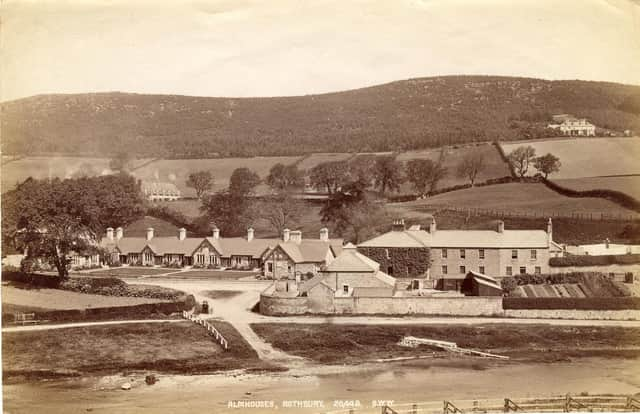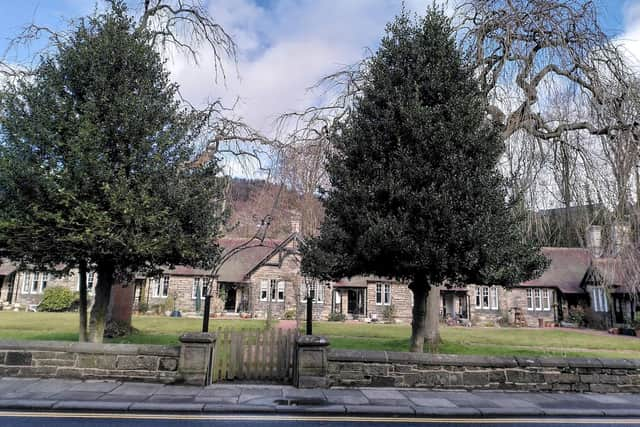Rothbury weeping ash trees have witnessed astonishing changes over last century


The cottages are situated at Town Foot, opposite the flood gates. Within the grounds of the cottages are two rather beautiful and imposing weeping ash trees.
There are also two lovely holly trees at the gate, as you enter, in the middle. The weeping ash trees were planted some years after the cottages were built, probably about 1909-10.
Advertisement
Hide AdAdvertisement
Hide AdNotice in the photograph taken from the mart, no holly or weeping ash trees have yet been planted. (There are no stepping stones across the Coquet either).


In summer 2021 I accompanied Nick Johnson of the Northumbria Veteran Tree project to survey these ‘notable’ weeping ash trees, and he gauged their age to be around 110 years old. (The Northumbria Veteran Tree Project aims to identify veteran, heritage and notable trees across the regions of Newcastle, North Tyneside and Northumberland).
Armstrong Cottages comprise six dwellings facing the road, with three on each side and were listed as Grade II by Historic England in 1987.
The buildings are rock-faced stone with red clay tile roofs and a plaque in the centre of the cottages reads: “Erected by William George Baron Armstrong of Cragside in memory of Ann Armstrong, his much-loved mother, 1896”.
Advertisement
Hide AdAdvertisement
Hide AdFrom the census of 1901 we can see that there were 11 people living here. The youngest was Ella Hindmarsh, 15, and the three eldest, all 75. Three residents were dressmakers, two are described as ‘paupers’ which is interesting, as the workhouse was situated right next door to these cottages. No doubt all the residents at the time would have been delighted to watch the planting of these very popular trees.
The weeping ash variety was cultivated as an attractive ornamental tree. These trees became very popular for planting in large gardens and parks in the mid-1800s. It is not easy to find the exact origins of these decorative trees; the earliest reference I have been able to find is c.1749. Their popularity grew during the Victorian era when they became very much sought-after.
The branches gracefully curve down – the Latin word ‘pendula’ in the name means ‘hang down’.
Weeping ash are created by grafting, which means combining one tree’s qualities (weeping) with the roots of another that is strong and resilient (an ash tree).
Advertisement
Hide AdAdvertisement
Hide AdSome plants and trees grown this way do not produce seeds which will grow into the desired combination. However, my research uncovered that weeping ash were being successfully grown from seed (keys) as early as 1780.
There are two other weeping ash about the same age as these two in the Armstrong graveyard, at Haw Hill. It would be great to discover who planted the four – if you have any idea, please let me know!The Armstrong Cottage trees are, unfortunately, nearing the end of a good long life, because of ash dieback. They have, however, lived a long time and have witnessed many fascinating changes during their life.
In 1909, for example, when they were just saplings, they may have been pleased to note a change in the law about the cars driving past them.
Rothbury agreed a speed limit of 10mph and this would have affected John Lee when, in 1912, he got his first charabanc and in 1913, his first garage was built. The trees would have seen, from 1919, the taxis and buses run by C F Wright – who had been a mechanic at John Lee’s garage – pass by on their journeys filled with excited passengers. (Later, in 1953, Wright bought out Lee’s Garage).
Advertisement
Hide AdAdvertisement
Hide AdThe trees would have got very wet ‘feet’ during the terrible flooding of 1927. The water is reported to have been waist deep at Town Foot. Elsewhere in Newcastle, The North Mail reported on August 9, 1927, ‘Inch and Half in Six Hours – Merciless Rainfall in North – Geyser Spectacle in High Heaton.’
However, the worst Rothbury floods in living memory were several decades later, in 2008. The current flood gates, which the weeping ash trees have a perfect view of, replaced the earlier ones in 2014/15.
If you observe the two weeping ash trees now, you will unfortunately see the evidence of ash dieback along the trunk, on the branches and crown of the trees. This disease arrived from mainland Europe and is a great threat not only to these two, but to all of our ash trees. Ash trees are a beautiful native tree, and its devastation by this disease is indeed a tragedy.
There have been 953 species identified as associated with ash trees, including birds, mammals, fungi and lichens. No other single alternative tree can replicate this, so the loss of the ash is a major tragedy for biodiversity.
Advertisement
Hide AdAdvertisement
Hide AdGiven the size and age of the Armstrong Cottages trees however, it must be noted that they still provide a good habitat for a range of species. One of our tree wardens, Professor Darren Evans, has witnessed a nuthatch, amongst other creatures, making good use of them.
There are many fascinating and beautiful trees in Rothbury, with many stories still to tell. You can read some of them on the Rothbury Tree website and blog, where you can find a longer version of this article.
www.rothburytrees.uk